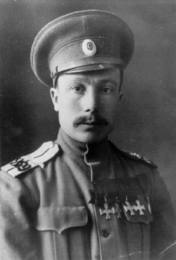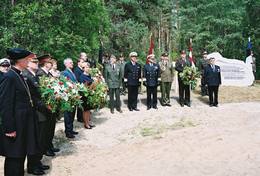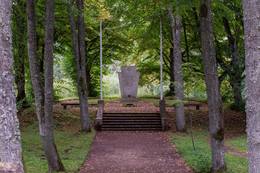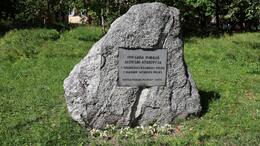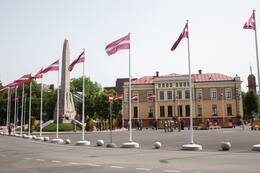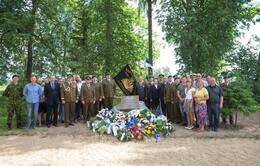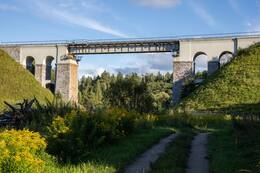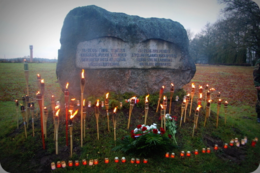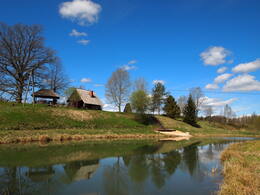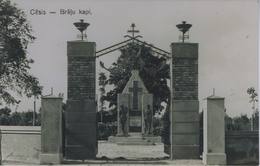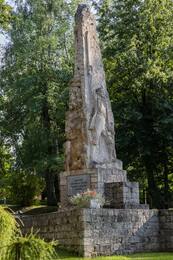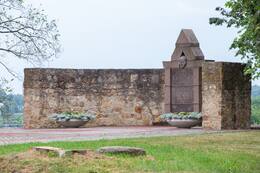Estų karių atminimo išsaugojimas Latvijoje
I Nepriklausomybės karai, Atkurta Nepriklausomybė
1918 m. vasario 24 d. paskelbta Estijos Respublika suteikė visapusišką ir reikšmingą pagalbą Latvijos Nepriklausomybės karo metu (1918-1920). Tai buvo Estijos kariuomenės dalyvavimas išlaisvinant Latvijos teritoriją tiek iš bolševikų, tiek nuo Landesvero, tiek nuo vokiečių geležinės divizijos, taip pat dalyvaujant Latvijos ginkluotųjų pajėgų Šiaurės Latvijos brigados organizaciniame kūrime ir aprūpinime. Daug kartų Latvijos Nepriklausomybės karo metu estų kariai atliko lemiamą vaidmenį nugalėdami priešą, tačiau tai kainavo ir daugelio estų karių gyvybes. Tai Latvijoje liudija žuvusių estų karių broliški kapai, taip pat paminklai, skirti bendroms estų ir latvių kovoms ir pergalei. Daugelis atminimo vietų yra susijusios su 1919 m. Cėsių mūšiu, kuris ypač pasižymėjo abiejų šalių nepriklausomybės karuose. Atminimo vietos paminklais pradėtos žymėti iškart po Latvijos Nepriklausomybės karo, tačiau sovietų okupacijos metais daugelis paminklinių vietų buvo sunaikinta arba apgadinta. Prasidėjus Trečiajam pabudimui, bet ypač atkūrus Estijos ir Latvijos nepriklausomybę, buvo ne tik atstatyti sugriauti paminklai, bet ir sukurtos naujos memorialinės vietos, pagerbiančios Estijos karių atminimą.
Pirmasis paminklas žuvusiems Estijos kariams buvo atidengtas 1923 metų rugpjūtį už vietos bendruomenės paaukotas lėšas Veselavos kapinėse, kuriose 1919 metais buvo palaidota 16 Estijos karių, kritusių Cėsių mūšyje. Prie Salacos upės kranto Mazsalacoje įkurtos ir broliškos kapinės estų kariams, žuvusiems 1919 metais Šiaurės Latvijos išvadavimo kovose. Pirmą kartą jie buvo pašventinti 1927 m., tačiau 1936 m., sutvarkius vietą, kapus pašventino ir Estijos kunigas. 2013 metų birželio 18 dieną ant šios kapinių kalvos vyko paminklo Latvijos išsivadavimo kare žuvusių Estijos karių brolių kapo atidarymas. Taip pat Salaspilyje, šalia senųjų kapinių, yra kelių už Latvijos nepriklausomybę kritusių estų karių kapas, kuriame pirmą kartą paminklas buvo pastatytas 1929 m.
Reikšmingiausias paminklas, skirtas bendrai estų ir latvių kovai ir pergalei 1919 m. Cėsių mūšyje, yra Pergalės paminklas Vienybės aikštėje Cėsiuose. Paminklas, suprojektuotas architekto Paulo Kundziņso ir pagamintas iš Allaži travertino, buvo atidengtas 1924 m. 1951 m. kovą sovietinės okupacinės valdžios įsakymu paminklas buvo susprogdintas. 1998 m. lapkričio 15 d. buvo atidengtas restauruotas paminklas, pastatytas iš Saremos dolomito. 1935 m. rugpjūtį Liepoje buvo atidengtas paminklas žuvusiems Estijos ir Latvijos kariams, sukurtas skulptoriaus Augusto Julla. 2004 m., minint Cėsių mūšio 85-ąsias metines, Priekulių valsčiuje, greitkelio Cėsis-Valmiera pašonėje, prie tilto per Raunos upę, buvo atidengtas paminklinis akmuo šiose kautynėse žuvusiems 110 Estijos ir 44 Latvijos karių. Priekulių apskrityje, Skangalių dvare, minint Cėsių mūšio 100-ąsias metines, buvo atidengtas paminklinis akmuo, skirtas Cėsių mūšio dalyviams ir Kalevlaste Maleva bataliono kovotojams pagerbti. 2009 metų birželį netoli Stalbės, Pārgaujos savivaldybėje, buvo atidengtas paminklas Cėsių mūšyje žuvusiems Viljandi mokyklų kuopos kariams. 2011 metų gegužę Valmieroje atidengta lenta prie Šv. Simono bažnyčią, skirtą 1919 metų gegužės 26 dieną, kovodamas su bolševikais, bažnyčios bokšte kritusiam Viljandi mokyklos kuopos kariui Viktorui Andersonui. Pažymėtina, kad Plėnų valsčiuje, plento Strenči-Valka 3 kilometre, 1994 metais buvo atidengtas paminklas Estijos kariuomenės šarvuotųjų traukinių divizijos vadui kapitonui Antonui Irvui, 1919 metų balandžio 27 dieną kritusiam mūšyje su bolševikais.
Daugiau informacijos šaltinių
Jānis Lismanis 1915-1920 mūšiams ir žuvusiems kariams atminti: Pirmojo pasaulinio karo ir Latvijos išsivadavimo kovų atminimo vietos. - Ryga: NIMS, 1999 m.
Estijos karių kapinės Mazsalacoje: https://www.arhitektivb.lv/projekti/88/igaunu-karaviru-kapi-mazsalaca
Estijos kariui [Viktorui Andersonui] sukurta memorialinė lenta https://www.eliesma.lv/valmiera-izveidota-pieminas-plaksne-igaunu-karaviram
Ragina sutvarkyti kapitono Irvo memorialinę vietą. Latvijos laikraštis, 2014.06.05. https://www.la.lv/aicina-uz-kapteina-irva-pieminas-vietas-sakopsanu
Susijusi laiko juosta
Susijusios vietos
The first monument to the Battle of Cēsis and the fallen Estonian soldiers
Located next to the Veselava cemetery chapel.
The first monument to the Battle of Cēsis and the fallen Estonian soldiers was unveiled on August 5, 1923.
The first President of the Republic of Latvia Jānis Čakste and the Estonian Ambassador to Latvia Jūlijs Saljema took part in its opening.
16 Estonian soldiers were buried in the cemetery, who fell in June 1919 in the battles of Cēsis with the Baltic Landesver and the Iron Division. Four of them were later reburied in their homeland. The monument was built on donations collected by locals. It was made by craftsman Dāvis Gruzde according to the design of Kārlis Bierņš, the owner of Ķikuri houses.
Memorial to the captain of the Latvian and Estonian hero Anton Irva (1886-1919)
Located in Plāņi Parish near Strenči, 3rd kilometer of Strenči-Valka highway.
The idea to build a monument on the site of the battle with the Bolsheviks on April 27, 1919, Captain Anton Irvs, commander of the Estonian Armored Army Division, originated in the 1930s. In November 1937, the jury of the sculpture committee awarded the first prize to the sculptor Ernst Jõesaar out of 14 monument projects submitted to the competition.
In 1939, the foundation stone of the monument was laid, as evidenced by the author's mark and year engraved in front of the base. However, the construction of the monument itself could not be started before the communist occupation.
The idea to build a monument was restored after the two countries regained their independence, and it was unveiled on April 23, 1994.
In front of the base of the monument is the year "1939", which is divided by a stylized sign made by the sculptor's initials "EJ". On the other side of the monument is the text “ESHL 1994” (Eesti Söjahaudade Hoolde Lüt, translated by the Estonian Soldiers' Cemetery Association).
Note. Antons Irvs is buried in the Viljandi cemetery in Estonia.
Memorial stone in the battles of Cēsis near the fallen Latvian and Estonian soldiers
Located in Priekuli Parish, on the side of the Cēsis-Valmiera highway near the bridge over Rauna.
A memorial stone with a granite memorial to the soldiers killed in the battles of Cēsis, made by stonemason Voldemārs Koltovs, can be seen.
Discovered in 2004, when the 85th anniversary of the Battle of Cēsis was celebrated.
A memorial stone to 110 Estonian and 44 Latvian soldiers killed in battles on the banks of the Rauna and Gauja banks.
The 6th Regiment of the 3rd Estonian Division (Commander K.Tallo), the 3rd Regiment (Commander J. Krūss) and the 2nd Cēsis Regiment of the Northern Latvia Brigade (Commander K.Berķis) fought heroically in the battles near Rauna and Gauja.
Memorial to Estonian soldiers killed in the Latvian War of Independence
Located on the bank of the river Salaca, near the cemetery, Upes Street 3a.
The cemetery was consecrated for the first time in June 1927. In the spring of 1936, at the suggestion of the local guard organization, a cemetery hill was created, where two unknown Estonian soldiers were reburied. The cemetery was consecrated on August 16, 1936. During both the German and Soviet occupation, the cemetery stood abandoned, surrounded by linden trees.
The Estonian Ministry of Defense, in co-operation with the Latvian Ministry of Defense and the Brothers' Cemetery Committee, accepted the Latvian side's proposal to concentrate all individual burials of fallen Estonian soldiers in Mazsalaca, where an ensemble of 2 Estonian soldiers had already been formed after the Freedom Fights.
On June 18, 2013, the monument to the Brothers' Cemetery of Estonian soldiers killed in the Latvian War of Liberation was unveiled on this cemetery hill. The monument was made of Saaremaa dolomite by the Estonian company Dolokivi OÜ after SIA Arhitektu birojs Vecumnieks & Bērziņi. The Minister of Defense of Estonia Urmas Reinsalu and the Minister of Defense of Latvia Artis Pabriks participated in the opening.
On November 11, 2015, 10 new reburials of unknown soldiers who died in the War of Independence were consecrated.
Memorial stone to the liberators of Alūksne
Located in Alūksne, at the intersection of Helēnas and Alsviķu streets.
The memorial stone was unveiled on May 29, 1999, the 80th anniversary of the liberation of Alūksne. The stone forging was performed by the sculptor Ainārs Zelčs.
On March 31, 1919, a Northern Latvian brigade was founded in Tartu to liberate Vidzeme and Latgale. The brigade consisted of the combined 1st Valmiera and 2nd Cēsis Infantry Regiment, later also the Northern Latvian Partisan Regiment, two cavalry squadrons and two artillery batteries. On May 26, these forces occupied Valmiera, but on May 27, the 1st Valmiera Infantry Regiment together with the 2nd Estonian Cavalry Regiment attacked in the direction of Alūksne. The Bolsheviks were unable to repel further attacks and on May 29, 1919, Aluksne was liberated.
Victory monument in Cēsis
The Victory Monument to Latvians and Estonians killed in the Battles of Cēsis is located in the city of Cēsis, on Vienības Square. In honour of the participants of the 1919 Battles of Cēsis, on 22 June 1924, the first stone was laid for the Victory Monument as sketched by architect Pauls Kundziņš, using funds donated by the people. During the Soviet occupation regime, on the night of 25 March 1951, the monument was blown up and taken down completely. A monument to Lenin, created by sculptor Kārlis Jansons, stood on the former Victory (Unity) Square from 1959 to 1990. In 1997, Māris Niklass, chairperson of the Cēsis District Council, managed to involve Estonian state institutions in the restoration of the monument. The material needed for the construction of the monument, Saaremaa dolomite, was received from Estonia as a gift. On 22 June 1998, during the celebrations of the 79th anniversary of the Battles of Cēsis, the first stone of the monument to be restored was laid on Vienības Square. A ceremony to unveil the restored Victory Monument took place in Cēsis on 15 November 1998 (author: architect Imants Timermanis). Information about the Victory Monument is available in the ‘Cēsis and the Latvian War of Independence’ exhibit of the Cēsis History and Art Museum, in the New Castle.
Memorial at Skangaļi Manor
The memorial to the victory of the combined Latvian and Estonian troops in the battle for the Skangaļi Manor is located about 20 kilometres from Cēsis. Devoted to the participants of the Battles of Cēsis and the fighters of the Estonian Kalevlaste Maleva Battalion, the memorial stone was unveiled on 22 June 2019. The victory of the combined Latvian and Estonian troops in the battle for the Skangaļi Manor, which took place here, was a turning point in the Battles of Cēsis, as a result of which the troops of Niedra’s government initiated a general retreat. The government of Andrievs Niedra was a provisional pro-German government of Latvia, which existed from 10 May to 26 June 1919. The attack on the Landeswehr unit began in the early morning of 22 June 1919 when the 3rd Kalev company used an armoured train to break into the Skangaļi Manor where they seized 2 cannons, however, the enemy still went on a counterattack. The troops repeated the attack slightly later, in the middle of the day, and the Landeswehr unit was forced out of the Skangaļi Manor following fierce close combat. The trophies from the battle include machine guns, large quantities of ammunition and other combat equipment. Two hours later, the Estonians captured an important road junction at the Starti pub. 58 Kalev soldiers were injured or lost their lives in the battle to capture the Skangaļi Manor. Estonia provided significant support in establishing the memorial site.
The railway bridge over the river Rauna
The railway bridge over the River Rauna is located near the P20 highway, in Priekuļi parish. It can be viewed from the right side of the Cēsis-Valmiera highway. The railway bridge is not intended for pedestrians and is watched over by security guards. Built in 1889, the masonry bridge on the Riga-Valka railway line is the highest railway structure of its kind in the Baltics. It is 24 metres high and 78.9 metres long. Trains, especially heavy freight trains, must maintain a speed of 80 km/h. Higher speeds are not allowed on the bridge. However, at lower speeds, the train is unable to deal with the slight incline on both sides of the bridge and may start to slide backwards. In June 1919, during the Estonian and Latvian Wars of Independence, reinforcements to the Estonian Army, which also included the Northern Latvian Brigade, were sent by rail across the bridge from Valka, which was at the back of the front. When the 2nd Cēsis Infantry Regiment was forced to retreat from Cēsis, its units strengthened their positions on the banks of the River Rauna. The railway bridge became part of the fortification and ensured the movement of Estonian armoured trains during the battles. During World War II, on 4 July 1941, the bridge was blown up by the fleeing Red Army when the Soviet occupation of Latvia was replaced by the German occupation. German Army sappers restored the bridge within a week. After World War II, during the Soviet occupation, the bridge over Rauna was of military strategic importance and was heavily guarded.
Monument for students of the Viljandi Regiment
The monument to the soldiers of the Viljandi Students’ Company who fell near Stalbe is located by the intersection of the Riga-Limbaži road, after making a turn onto the Stalbe-Stūrīši road, which leads to the Pārgauja Municipal Council (to the right). Latvian and Estonian inscriptions on the granite memorial read: ‘On 19-21 June 1919, during the Battles of Stalbe, the 6th Regiment Viljandi Students’ Company repelled the attack of the Germans’. The monument was unveiled on 19 June 2009. Based on the idea conceived by Mareks Niklass, the monument was created by stonemason Voldemārs Koltovs. The 6th Estonian Regiment fought the Baltic Landeswehr and the Iron Division during the Battles of Cēsis near Stalbe. The Germans tried to break the front line in the area of the Stalbe Manor but were forced to retreat after two days of failed attempts. Every year, Lāčplēsis Day celebrations in Stalbe begin with a torchlight procession to the monument devoted to the soldiers of the Viljandi Students’ Company.
poilsio vieta „Miško mūšis“ (Meža kaujas) – Cėsių mūšių svarbiausios veiksmo vietos prie Amatos tilto
Named Forest Battles, the rest area is situated in the main location of the Battles of Cēsis near the Amata bridge. Visitors can listen to stories about the Battles of Cēsis and can take part in various activities, including hikes and trips around the most important venues of the Battles of Cēsis, and team battles. At the end, the visitors can enjoy an invigorating wartime soup. The railway bridge over Amata played a very important role throughout the War of Independence, as the first clashes of the Estonian Army with the Landeswehr took place here. On 5 June 1919, the first battle of the Estonian Army’s armoured trains with the Baltic Landeswehr units took place by the railway bridge over Amata. The Landeswehr, knowing that an armoured train was approaching, planted mines on the railway bridge and secured positions at the homestead Amatas on the riverbank in preparation for a possible battle. The bridge over Amata marked the border between Estonian forces and the Germans. On the night of 23 June 1919, during the Battles of Cēsis, the Landeswehr left Cēsis and retreated to the Amata river line. When retreating, the Germans burned down the Cēsis Latvian Society House and blew up the bridge over Amata.
A unique opportunity is offered to watch the events of June 5, 1919 through virtual reality glasses.
Cesis Brothers Cemetery
Located in Cēsis Lejas Cemetery, Lenču Street 15, Cēsis.
One of the most important memorial sites of the First World War and the War of Independence in Cēsis is the Brothers' Cemetery in the Lower Cemetery.
The cemetery is the monument of the Brethren's Cemetery, built in 1927 by the artist and thinker of Cēsis Augustus Julla (1872-1958), dedicated to the soldiers buried in the Brothers' Cemetery from 1915 to 1920.
About 200 soldiers are buried in the Brothers Cemetery of Cēsis Lower Cemetery. Among them, an unknown number of Latvian riflemen and Russian soldiers killed in the First World War, as well as soldiers of German (10), Polish and other nationalities. During the Latvian Liberation War, 22 fallen soldiers of the 5th (2nd) Cēsis Infantry Regiment, as well as 11 freedom fighters who fell in other Latvian army units, were buried in these cemeteries. 2 Estonians, 15 victims of Bolsheviks and also Latvian Red Riflemen are buried in the Brothers' Cemetery.
Memorial plaque to Viktor Anderson, a soldier of the Viljandi Schoolchildren's Association who died in the War of Independence
Located on the outer wall of Valmiera St. Simon's Lutheran Church.
The memorial plaque was unveiled on May 26, 2011, marking the anniversary of the liberation of Valmiera from the Bolsheviks. The plaque is dedicated to Viktor Anderson, a soldier of the Viljandi Schoolchildren, who fell in the battle of the Bolsheviks on May 26, 1919.
September 23, 1928 A granite slab has been unveiled in Simon's Church for members of the Valmiera-Veide congregation who fell during the liberation of Latvia and the World War. The plaque was destroyed during the Soviet occupation. On November 11, 1995, a new plaque was unveiled.
On August 11, 1935, St. A granite slab was unveiled and consecrated in Simon's Church for 70 members of Valmiera-Valmiermuiža parish. The plaque was destroyed during the Soviet occupation. A new one was opened in 1995.
Monument commemorating the Cēsis battles
The monument to the Estonian and Latvian soldiers who died in the Battles of Cēsis is located in Priekuļi municipality, Liepā, about 1 kilometre south of the Lode Railway Station, on the side of Rūpnīcas street. The first stone of the monument was laid on 22 September 1929, and the monument was unveiled on 11 August 1935. Based on a sketch by Sculptor Augusts Julla who lived in Jullas, Liepa parish, and made of limestone from the village of Allaži, the monument is a high-relief depiction of a peasant soldier leaning on a plough with one hand and a raised sword in the other. The death mask of the sculptor’s father Jānis Julla was used to create the face of the sculpture. According to Aivars Vilnis, a researcher of the history of Liepa parish, a bird’s eye view of the monument reveals that the base of and the path and stairs leading to the monument form the shape of an arrow facing Liepa Manor (Lindenhoff) in the direction of German positions during the Battles of Cēsis. There is doubt, of course, as to whether this was truly the author’s intention at the time; however, it certainly enriches our interpretation of the monument today. Next to the monument are the only natural sandstone arches in Latvia known as ‘Lielā Ellīte’ (‘Liepas Ellīte’ or the Devil’s Kiln).
A monument to the soldiers who died in the battles for the liberation of Latvia in Jaškov
The road section Viļaka – Vientuļi (P35) is on the left side of the road, near the chapel of the Jaškova grave.
Monument to Latvian and Estonian soldiers who died in the War of Independence.
The monument created by the sculptor Kārlis Zemdega in 1920 in memory of the soldiers who fell in the Freedom Struggle in Jaškov was first unveiled on September 22, 1935 at the graves of the Viļaka brothers established in 1929.
The struggle for freedom against the Red Army in Viļakas district began with the attack of the Latvian army and the Latgale partisan regiment on January 9, 1920. Estonian soldiers also participated in it. Viļak was liberated already on January 9, but the fighting to the east of it continued for several more days. Both before and after the liberation of Vilakas, the fallen soldiers were buried in different places known to local residents. As the state of Latvia stabilized, Viļakas began to think about setting up joint graves of brothers. Already from November 18, 1923, after a solemn service in the Catholic church, held by dean P.Apšinīks, a large procession went to the newly formed burial place of the brothers on the hill, in the so-called Jaškov - in the immediate vicinity of Viļaka. Soon, the foundation of the monument was built, the collection of donations for the monument began. Identifying the graves of the fallen soldiers took time, only on November 3, 1929, the reburial took place in the future graves of the brothers. The 31 Latvian and 14 Estonian soldiers who fell in the vicinity of Viļakas were buried in them. In 1935, the monument was ready and on September 22, it was solemnly consecrated.
In the pre-war years of Latvia's independence, all important national events in Viļaka parish were connected with the brothers' graves and this monument.
The monument was destroyed during the post-war years of Soviet rule, but its granite parts, although damaged, were preserved. The monument was restored on November 11, 1990 - Lāčpleš Day.
Monument "To those who fell for the Fatherland 1918 - 1920."
It is located on the edge of Riga Street, opposite the Krustpils Palace.
In Jēkabpils, on the right bank of the Daugava, the proposal for erecting a monument to the fallen soldiers of the Freedom Struggle for the monument "Fallen for the Fatherland 1918 - 1920" was made by the Krustpils branch of the Latvian Brothers' Graves Committee on June 12, 1923. For the creation of the monument, on November 12, 1923, the Krustpils Parish Board handed over the stone part of the Tsar Alexander II monument at the parish board building, where the monument was installed in honor of the abolition of serfdom, to the disposal of the Fraternal Graves Committee. The Ministry of the Interior of Latvia allowed the Krustpils branch of the Fraternal Graves Committee to collect donations. In total, 2,400 lats were donated, 1,200 were missing. It was hoped to get them from the bazaar and social evening organized on the opening day of the monument.
The project of the monument is entrusted to the architect Aleksanders Birznieks. The architect's plans were to create a monument from local material - dolomite studs. The volume of the monument was formed by two concentric, massive semi-circles of dolomite stud masonry, the outer one on the Daugava side was lower, cut into the shore and formed a terrace. In its center was a fire cross made of red bricks. In the center of the main half-circle, as an altar, granite plates with the text: "Fallen for the Fatherland 1918 - 1920" and depicting the rising sun above the waves of the Daugava, framed by Latvian symbols. The central part of the monument was formed by the mask of the fallen soldier, which was forged by the sculptor V. Trejs. The Acting Commander of the Latgale Artillery Regiment, Lieutenant Colonel Jākobsons, allowed the use of the square on the right bank of the Daugava opposite the Krustpils Castle for the construction of the monument, on the condition that the square remains the property of the Latgale Artillery Regiment.
In 1925, the Krustpils branch of the Latvian Brethren Cemetery Committee concluded a contract with businessman V. Treija from Riga for the construction of a monument in Krustpils. On July 26, 1925, the foundation of the monument was laid. September 27, 1925 is a holy day for Crusaders. The opening of the monument is taking place with its consecration by the Lutheran pastor of Krustpils parish K. Skujiņš. The Minister of War R. Bangerskis, the commander of the Latgale Artillery Regiment, Colonel Kire, General K. Berķis, etc. participate in the construction of the monument.
20th century In the 1950s, the monument "Fallen for the Fatherland 1918 - 1920" was partially destroyed - the upper part was demolished - the mask of ancient Latvian soldiers, smeared inscriptions, destroyed fire cross sign. On the other hand, already at the beginning of the Third Awakening, the activists of the Krustpils branch of the Latvian People's Front (LTF) in the first regional conferences of the LTF wrote in the resolution the demand to restore the monument in Krustpils. Already on November 11, 1989, at the place where the monument was located, a commemoration was held in which the people of Jēkabpils remembered their Lāčplēši.
At the beginning of 1992, the restoration works of the monument were started. Granite pieces of the required size and shape are manufactured at the Cēsis utility company combine. The granite was processed according to the drawings by E. Nīmanis and V. Treikmanis. The technical supervision of the restoration of the monument is carried out by architect Māra Steķe. In Riga, the sculptor Inta Berga cast the bronze details of the monument. All works were financed from Jēkabpils city funding. The renovated monument was consecrated by Modris Plāte, the then-present rector of Jēkabpils and Krustpils Evangelical Lutheran Church, and Jānis Bratuškins, pastor of Jēkabpils Catholic Church, on November 18, 1992.
Opened in Krustpilis on September 27, 1925. The monument was designed by the architect Aleksandar Birzeniek. The inscription "Fallen even for the Fatherland 1918-1920" is carved into the monument. The monument was partially demolished by the Soviet occupation power in 1941, it was completely destroyed around 1950. The monument was renovated on November 18, 1992.
Susijusi istorija
Cėsių mūšio pradžia, eiga ir pabaiga
Pergalei Cėsių mūšyje buvo lemta tapti lūžiu latvių ir estų kovoje už savo šalies nepriklausomybę. Ši pergalė padarė tašką Andrievo Niedros vyriausybės ir vokiečių generolo Rüdigerio von der Goltzo planams užkariauti Baltijos šalis. Vietoj to Liepojoje savo veiklą atnaujino Laikinoji Latvijos vyriausybė, vadovaujama Kārlio Ulmanio.
Estijos karinis jūrų laivynas padeda Latvijos pajėgoms Nepriklausomybės karo metu
Birželio 23 dieną estai švenčia Pergalės dieną, pažymėdami bendrą Latvijos ir Estijos pergalę Cėsių mūšyje. Ir šioje pergalėje nemažą vaidmenį suvaidino Estijos karinis jūrų laivynas, kuris šiame Landesvero kare, kaip jį vadina estai, savo drąsiais veiksmais ir tikslia patrankų ugnimi Dauguvos žiotyse kėlė grėsmę pagrindiniams vokiečių pajėgų tiekimo maršrutams per Dauguvą visai netoli Rygos.
Šiaurės Latvijos kariuomenės įkūrimo Rūjienos pusėje fragmentas
Šiaurės Latvijos armija buvo Latvijos karinė formacija Latvijos nepriklausomybės karo metu, kuri buvo suformuota 1919 m. vasario 3 d. – kovo 31 d. Estijos teritorijoje ir Estijos kariuomenės išlaisvintuose šiauriniuose Vidžemės regionuose. Iki 1919 metų liepos brigada logistikos ir operacijų atžvilgiu buvo pavaldi Estijos ginkluotųjų pajėgų štabui ir Estijos kariuomenės vyriausiajam vadui. Tada ji buvo sujungta su Pietų Latvijos brigada ir suformuota Latvijos armija.
Sovietų Sąjungos didvyrio žygdarbis - leitenantas Jakobas Kunderis iš 8-ojo Estijos korpuso
Didvyriški žuvusio Raudonosios armijos Estijos 8-ojo šaulių korpuso karininko Jakobo Kunderos veiksmai užtikrino sėkmingą bataliono puolimą, tačiau jis pats žuvo, o Jakobui Kunderai žuvimo vietoje yra skirtas paminklas, Tuškų brolių kapinėse pastatytas paminklas.
Apie Latvijos nepriklausomybės karą ir 1919 metų įvykius Alūksnėje
1919 m. kovo 27 d. 1-asis Valmieros pėstininkų pulkas kartu su Estijos gvardijos (kaitselit) Talino (tuomet Rėvelės) ir Tērbato batalionais bei trimis šarvuotaisiais traukiniais nuo Melnupės upės krantų pradėjo Latvijos išvadavimą nuo bolševikų.
Šiaurės Latgalos išvadavimas iš bolševikų
1918 m. gruodžio 1 d. Raudonosios armijos daliniai, paremti Raudonųjų šaulių daliniais, įsiveržė į Latvijos teritoriją. Siekdami apsaugoti savo namus, šeimas, gimtuosius rajonus, pabėgti nuo siaubo, Balvi apylinkių vyrai griebėsi ginklo ir ėjo į miškus, pradėjo kurtis pirmosios „žaliosios“ grupės. 1919 m. pavasarį, kai buvo paskelbta mobilizacija, daugybei Balvų apylinkių vyrų kovoti sovietinėje Latvijos armijoje atrodė nepriimtini ir jie prisijungė prie „žaliųjų“ grupuočių. Susikūrė Balvų, Silakrogo, Rugėjų, Teterių-Dūrupės ir Liepnos grupės. „Žaliųjų“ grupių veikla Balvių apylinkėse suaktyvėjo 1919 metų kovo mėnesį.







